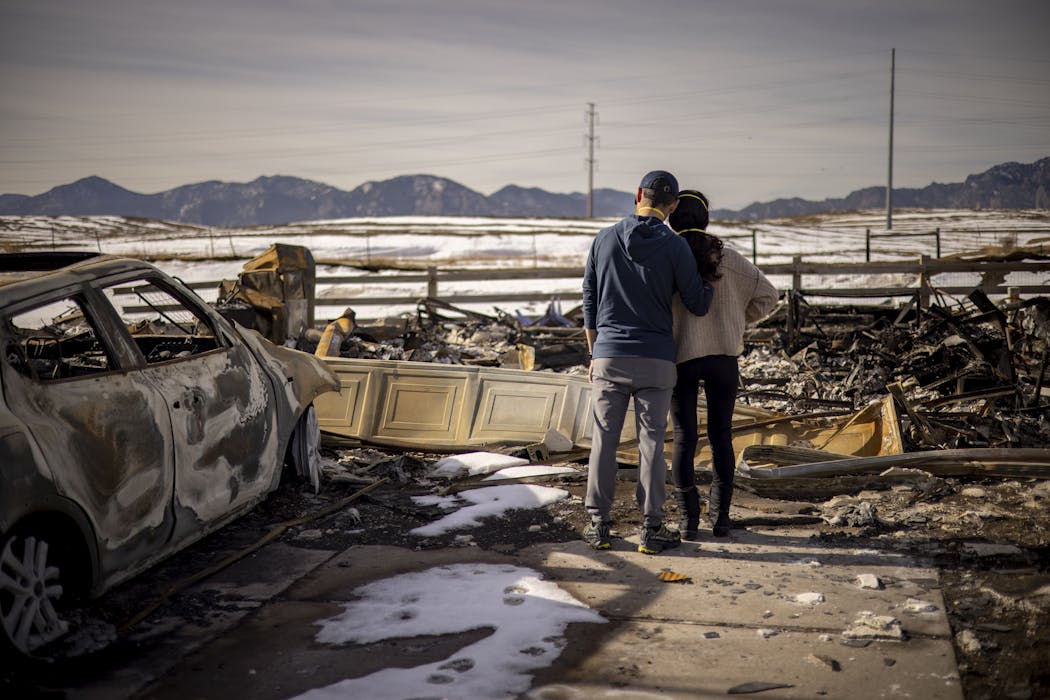Many Colorado homeowners are underinsured − here’s what to do before the next fire
- Written by Tony Cookson, Associate Professor of Finance, University of Colorado Boulder

Most Colorado homeowners do not have enough insurance coverage to rebuild their house after a total loss. That’s according to our new research examining whether homes destroyed in Colorado’s Marshall Fire[1] — which burned more than 1,000 houses in suburban Boulder County — have been rebuilt.
We are economists[2] who study[3] the financial resources available to households to cope with disasters, including insurance, crowdfunding and federal disaster aid.
Over the past five years, insurance premiums in Colorado rose nearly 60%[4], driven by mounting losses from wildfire, hail and other disasters. These patterns are not unique to Colorado. They reflect a broader national reassessment of risks[5].
Our new research sheds light on this issue by linking confidential, contract-level data[6] to real rebuilding outcomes.
Our study analyzes 3,089 policies from 14 major insurers held by people affected by the Marshall Fire. The findings offer concrete steps homeowners can take now to reduce the risk of holding insufficient coverage.
How common is underinsurance?
Underinsurance is determined by comparing the amount of coverage a homeowner carries to rebuild the physical structure of their home to the actual cost of rebuilding after a disaster.
To estimate each unique home’s rebuilding cost, the study used construction-cost software and adjusted the estimates to align with a sample of real-world construction quotes received by homeowners after the Marshall Fire.
We found that 74% of homeowners affected by the Marshall Fire were underinsured, and 36% were so severely underinsured that their policy covered less than 75% of the rebuild cost.
According to our research[7], underinsurance was not just a problem for poorer households. Even for households with incomes above US$180,000, 72% held policies that did not cover the cost of a complete rebuild.
Credit scores and mortgage debt amounts were unrelated to how underinsured people were.
After major fires, construction costs typically spike as hundreds of survivors rebuild at once. To help manage this risk, many homeowners purchase an Extended Replacement Cost policy[9], which boosts coverage by a set percentage of the existing coverage limit if rebuilding costs end up higher than the coverage limit.
Eighty-seven percent of the Marshall Fire policies we studied included extended coverage. But nearly three-quarters of them still fell short of covering the full cost to rebuild[10]. Our study found that while extended coverage policies cushion the impact of postfire construction cost inflation, they do not solve the deeper problem of underinsurance.
In other words, even without the surge in costs, most households had bought too little coverage from the outset.
Price shopping vs. the coverage you actually need
Our research finds that the insurance company a household chooses strongly predicts how much coverage the household has. That’s even after accounting for income, mortgage status, credit score, home value and property characteristics. In other words, insurers differ systematically in the coverage levels they tend to provide.
When shopping, homeowners attend to the headline premium, or the total cost of insurance, but not to how much coverage that premium actually buys. Indeed, if shoppers compared insurer quotes for the same coverage amount, they would gain about $290 per year in value, roughly 10% of the average annual[11] homeowners insurance premium.
Why underinsurance slows recovery
Underinsurance isn’t an abstract problem offset by savings, loans and federal aid. It leaves real gaps in rebuilding.
The study found that when a household’s insurance coverage falls short of the home’s replacement cost, the household is significantly less likely to rebuild after a total loss. Instead, some families end up selling and moving away.
In fact, the research shows that if all underinsured households in the sample had been fully insured, 25.4% of homeowners would have filed for reconstruction permits within a year of the fire, instead of the 18.8% that filed. In addition, only approximately 5.4% of homeowners would have sold their destroyed properties that year, as opposed to the 9.7% that did sell. Overall, this means more families could have rebuilt and stayed in their communities.
What Colorado homeowners can do now
Here are some practical steps Colorado homeowners can take to make sure their coverage keeps pace with rising risks and rebuilding costs:
When getting quotes or renewing, request a side-by-side comparison where coverage limits and any extended coverages are held constant across insurers. Shopping this way helps avoid underinsuring in pursuit of a lower premium.
Revisit limits after renovations and big economic changes. Construction costs in the region rose steeply[13] in the lead-up to the Marshall Fire due to the pandemic and related inflation. If you haven’t updated your coverage recently, revisit it annually — especially if you remodeled or added square footage.
Consider insurer reputation and local presence. Different insurance companies will suggest different coverage limits for the exact same property. The study finds that companies with deeper roots in the community are less likely to underinsure, likely due to concerns about their reputation — something worth weighing alongside price.
The Front Range will continue to face wildfire seasons where wind, drought and human ignition[14] interact in populated areas, and premiums are unlikely to snap back quickly. For households, the most practical step is to shop for insurance and renew policies as if a total loss could happen tomorrow.
References
- ^ Marshall Fire (research.noaa.gov)
- ^ economists (www.tonycookson.com)
- ^ who study (sites.google.com)
- ^ Colorado rose nearly 60% (coloradosun.com)
- ^ national reassessment of risks (www.cbsnews.com)
- ^ linking confidential, contract-level data (papers.ssrn.com)
- ^ to our research (papers.ssrn.com)
- ^ UCG/GettyImages (www.gettyimages.com)
- ^ homeowners purchase an Extended Replacement Cost policy (www.sfchronicle.com)
- ^ fell short of covering the full cost to rebuild (www.insurancejournal.com)
- ^ roughly 10% of the average annual (www.nber.org)
- ^ UCG/GettyImages (www.gettyimages.com)
- ^ costs in the region rose steeply (coloradonewsline.com)
- ^ wind, drought and human ignition (www.fs.usda.gov)
Authors: Tony Cookson, Associate Professor of Finance, University of Colorado Boulder




